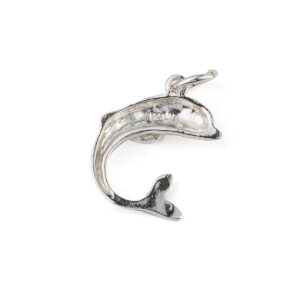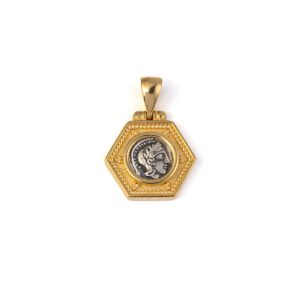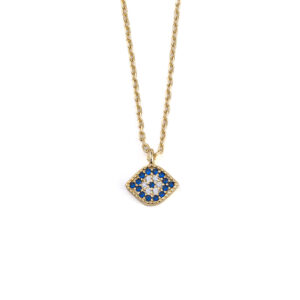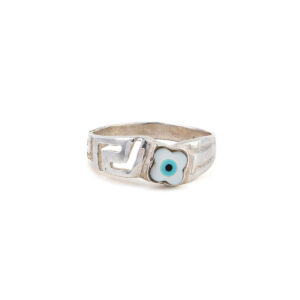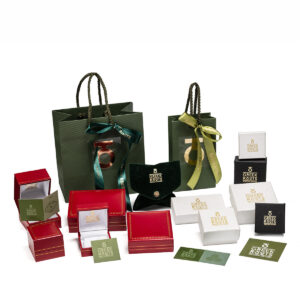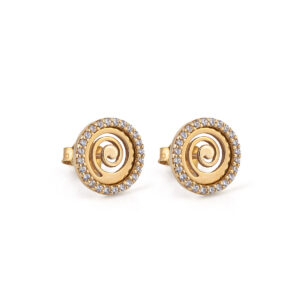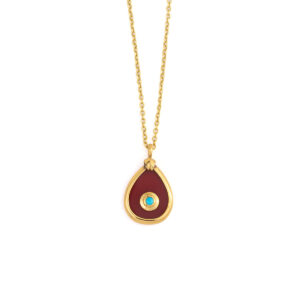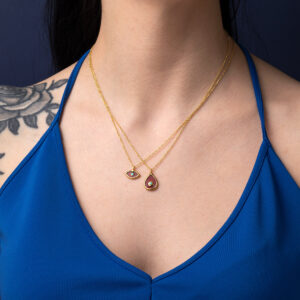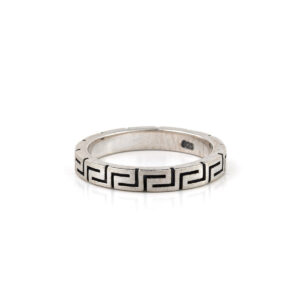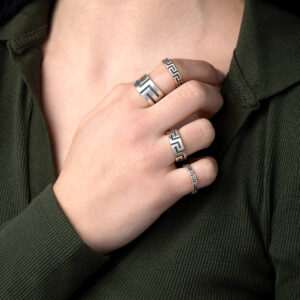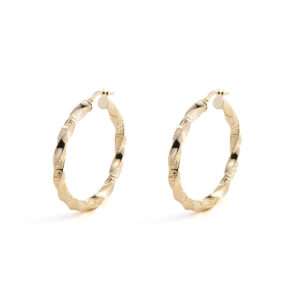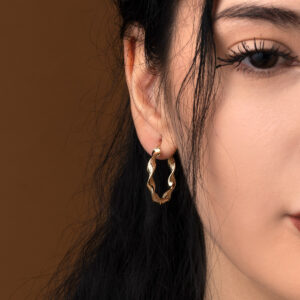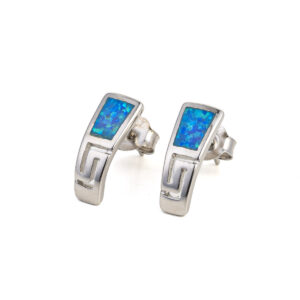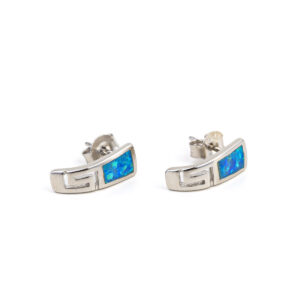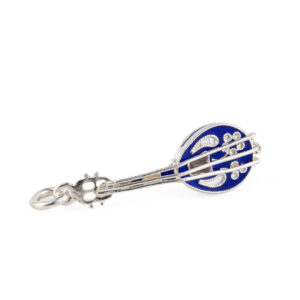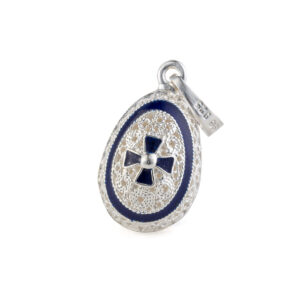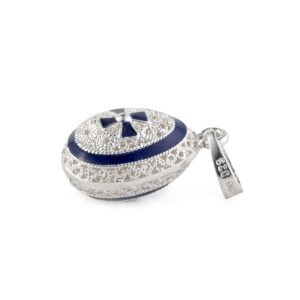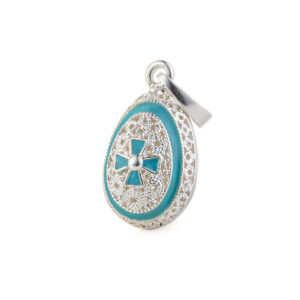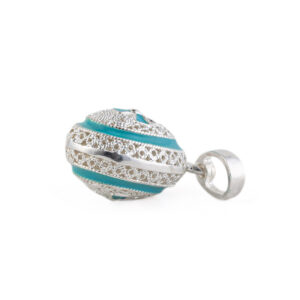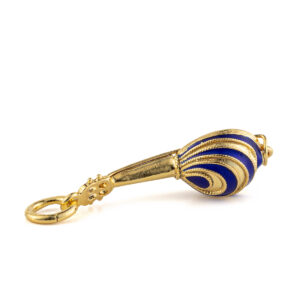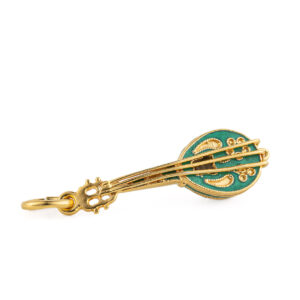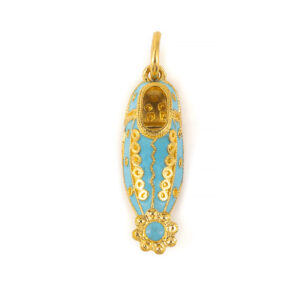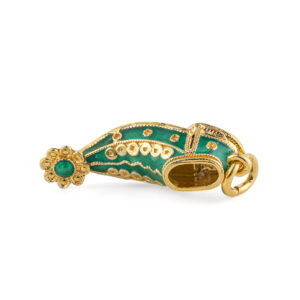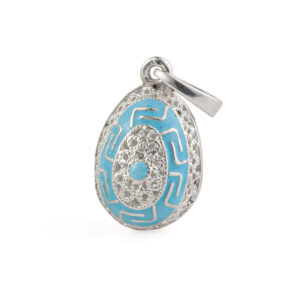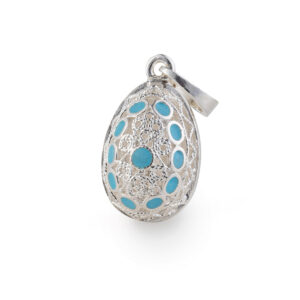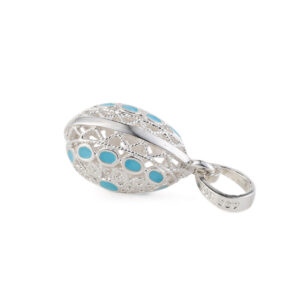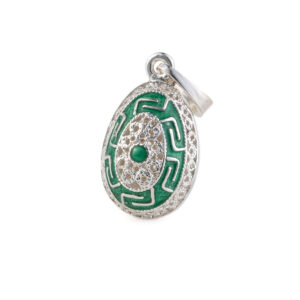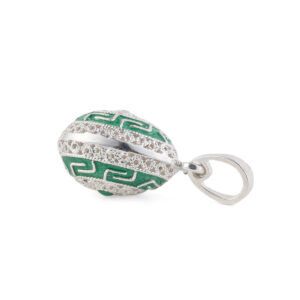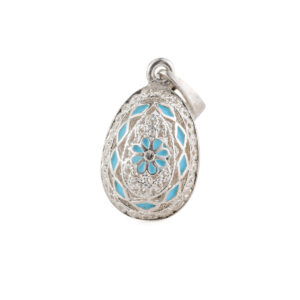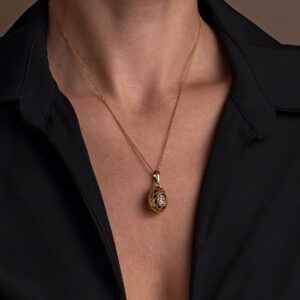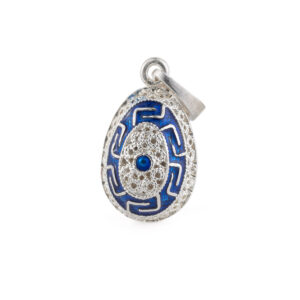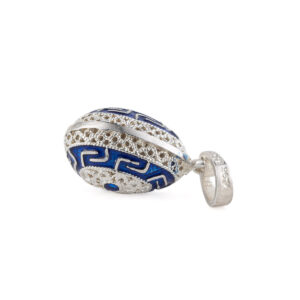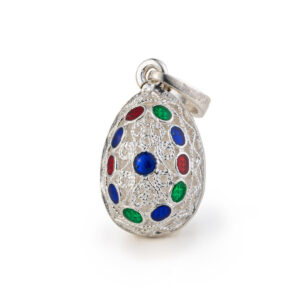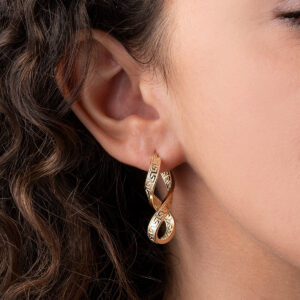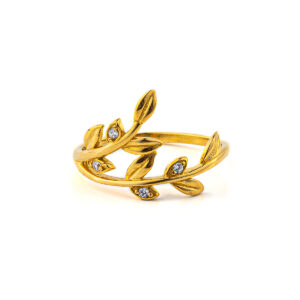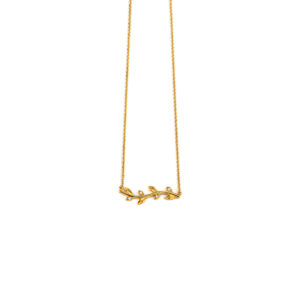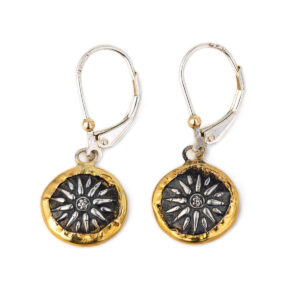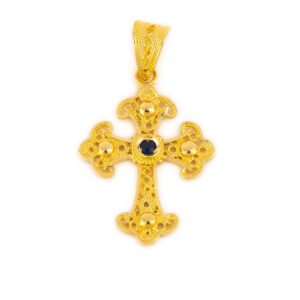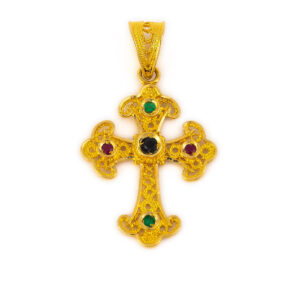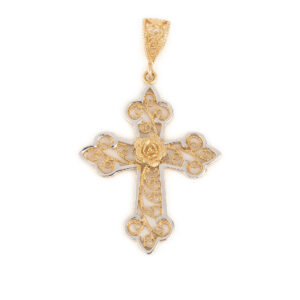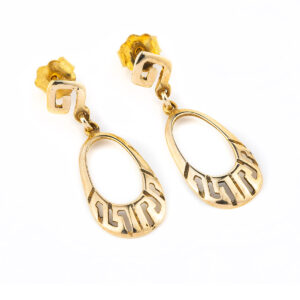Μενταγιόν Με Δελφίνι απο Ασήμι 925
Κατασκευασμένο από ασήμι 925.
Χειροποίητο Κόσμημα.
Η εικονιζόμενη αλυσίδα Ασήμι 925 Oxidised Αλυσίδα δεν συμπεριλαμβάνεται.
Ανακαλύψτε τη Συλλογή Κληρονομιά
Μενταγιόν Πεντάγωνο με την Θεά Αθηνά – Ασήμι 925 και Χρυσό 14Κ
Από ασήμι 925° και χρυσό 14 καρατίων.
Χειροποίητο ελληνικό κόσμημα.
Ανακαλύψτε τη Συλλογή Νομίσματα
Η θεά Αθηνά συνδέεται με τη σοφία, τη χειροτεχνία και τον πόλεμο. Η Αθηνά θεωρούνταν προστάτιδα και φύλακας διαφόρων πόλεων σε όλη την Ελλάδα, ιδίως της πόλης της Αθήνας, από την οποία πιθανότατα έλαβε και το όνομά της. Συνήθως απεικονίζεται στην τέχνη φορώντας κράνος και κρατώντας δόρυ. Τα κυριότερα σύμβολά της περιλαμβάνουν κουκουβάγιες, ελαιόδεντρα και φίδια. Οι ναοί της βρίσκονταν στην κορυφή της οχυρωμένης Ακρόπολης στο κεντρικό τμήμα της πόλης. Ο Παρθενώνας στην αθηναϊκή Ακρόπολη είναι αφιερωμένος σε αυτήν, μαζί με πολλούς άλλους ναούς και μνημεία. Η κύρια γιορτή της στην Αθήνα ήταν τα Παναθήναια, τα οποία γιορτάζονταν στα μέσα του καλοκαιριού και ήταν η σημαντικότερη γιορτή στο αθηναϊκό ημερολόγιο.
Κολιέ με Ματάκι και Ζιργκόν από Επιχρυσωμένο Ασήμι 925
Κατασκευασμένο από επιχρυσωμένο ασήμι 925.
Χειροποίητο ελληνικό κόσμημα.
Ανακαλύψτε τη συλλογή Μάτι
Η συλλογή περιλαμβάνει κοσμήματα με το σύμβολο του ματιού.
Δαχτυλίδι Μαίανδρος με Λουλούδι – Ασήμι 925
Κατασκευασμένο από ασήμι 925°.
Χειροποίητο Ελληνικό Κόσμημα.
Ανακαλύψτε τη Συλλογή Μαίανδρος
Ιστορία
Το σχέδιο Μαιάνδρου είναι ένα διακοσμητικό περίγραμμα που δημιουργείται από μια συνεχή γραμμή, η οποία σχηματίζεται σε ένα επαναλαμβανόμενο μοτίβο. Ένα τέτοιο σχέδιο ονομάζεται επίσης ελληνικός κροσσός ή ελληνικό σχέδιο κλειδιού, αν και πρόκειται για σύγχρονες ονομασίες. Από τη μία πλευρά, η ονομασία “μαίανδρος” θυμίζει τη στροφική πορεία του ποταμού Μαιάνδρου στη Μικρά Ασία, και από την άλλη πλευρά, όπως επεσήμανε ο Karl Kerenyi, “ο μαίανδρος είναι το σχήμα ενός λαβύρινθου σε γραμμική μορφή” το νόημα είναι ότι δεν υπάρχει αρχή και τέλος σε ορισμένες περιπτώσεις έτσι γίνεται το σύμβολο της μακράς ζωής και της αιωνιότητας.
Σκουλαρίκια Καρφωτά Σπείρα – Χρυσό 14Κ
492,00€Κατασκευασμένα από χρυσό 14 καρατίων.
Χειροποίητο Ελληνικό Κόσμημα
Ανακαλύψτε τη Συλλογή Σπείρα
Η σπείρα είναι ένα από τα παλαιότερα σύμβολα της ανθρώπινης πνευματικότητας, σκαλισμένο ή ζωγραφισμένο σε βράχους χιλιάδες χρόνια πριν. Σύμβολο της κίνησης και της προοδευτικής ανάπτυξης, της ανάπτυξης, της επέκτασης, της κοσμικής ενέργειας, σύμβολο του ήλιου… Σπείρες έχουν βρεθεί σε χώρους ταφής, σε αγγεία, σε κοσμήματα, ρούχα, όπλα… Μπορούν να παρατηρηθούν σε κάθε πτυχή της φύσης, όπως οι παλίρροιες στους ωκεανούς, οι άνεμοι, τα φυτά, τα κοχύλια. Το φαινόμενο της σπείρας έχει εξηγηθεί μέσω των μαθηματικών από την εποχή του Αρχιμήδη, του μεγάλου Έλληνα μαθηματικού.
Κολιέ Marquise με Ματάκι – Ασήμι 925
Κολιέ Marquise με Κρεμαστό Ματάκι
Κατασκευασμένο από ασήμι 925.
Χειροποίητο ελληνικό κόσμημα.
Ανακαλύψτε τη συλλογή Μάτι
Η συλλογή περιλαμβάνει κοσμήματα με το σύμβολο του ματιού.
Δαχτυλίδι με Μαίανδρο – 925 Ασήμι
Οβάλ Σκουλαρίκια Όπαλ με Μαίανδρο – Ασήμι 925
Σκουλαρίκια οβάλ με μαίανδρο φτιαγμένα από ασήμι 925 και πέτρες όπαλ.
Χειροποίητο κόσμημα.
Ανακαλύψτε τη συλλογή opal
Κολιέ με Μενταγιόν Μπουζούκι με Μπλε Σμάλτο – Ασήμι 925
Greek Bouzouki Charm with enamel. The pendant is decorated with rosette motifs.
Made of sterling silver.
Handmade item.
Design inspired by the Greek tradition.
Κολιέ με Μενταγιόν Αυγό – Ασήμι 925
The pendant is embellished with a fine filigree and enamel in Faberge style.
Made of 925 sterling silver.
Handmade in Greece.
The chain shown is included.
Filigree is a delicate kind of jewellery metalwork, made with tiny beads or twisted threads, or both in combination, soldered together or to the surface of an object of the same metal and arranged in artistic motifs. The art of filigree dates back to ancient history. The first of the found jewelry in this technique have been found in Mesopotamia and dates to thousands of years BC. In the ancient world and particularly in Asia Minor, this art grew were at the highest level.
Fabergé egg is a jeweled egg created by the House of Fabergé, in St. Petersburg, Imperial Russia. Virtually all were manufactured under the supervision of Peter Carl Fabergé between 1885 and 1917,[citation needed] the most famous being the 50 “Imperial” eggs, 43 of which survive, made for the Russian Tsars Alexander III and Nicholas II as Easter gifts for their wives and mothers. The first Fabergé egg was crafted for Tsar Alexander III, who had decided to give his wife, the Empress Maria Feodorovna, an Easter egg in 1885. Peter Carl Fabergé was a Russian jeweller best known for the famous Fabergé eggs made in the style of genuine Easter eggs, using precious metals and gemstones. He’s the founder of the famous jewelry legacy House of Fabergé.
Κολιέ με Μενταγιόν Αυγό – Ασήμι 925
The pendant is embellished with a fine filigree and enamel in Faberge style.
Made of 925 sterling silver.
Handmade in Greece.
The chain shown is included.
Filigree is a delicate kind of jewellery metalwork, made with tiny beads or twisted threads, or both in combination, soldered together or to the surface of an object of the same metal and arranged in artistic motifs. The art of filigree dates back to ancient history. The first of the found jewelry in this technique have been found in Mesopotamia and dates to thousands of years BC. In the ancient world and particularly in Asia Minor, this art grew were at the highest level.
Fabergé egg is a jeweled egg created by the House of Fabergé, in St. Petersburg, Imperial Russia. Virtually all were manufactured under the supervision of Peter Carl Fabergé between 1885 and 1917,[citation needed] the most famous being the 50 “Imperial” eggs, 43 of which survive, made for the Russian Tsars Alexander III and Nicholas II as Easter gifts for their wives and mothers. The first Fabergé egg was crafted for Tsar Alexander III, who had decided to give his wife, the Empress Maria Feodorovna, an Easter egg in 1885. Peter Carl Fabergé was a Russian jeweller best known for the famous Fabergé eggs made in the style of genuine Easter eggs, using precious metals and gemstones. He’s the founder of the famous jewelry legacy House of Fabergé.
Κολιέ με Μενταγιόν Μπουζούκι με Μπλε Σμάλτο
Greek Bouzouki Charm with enamel. The pendant is decorated with rosette motifs.
Made of sterling silver and gold plated.
Handmade item.
Design inspired by the Greek tradition.
Κολιέ με Μενταγιόν Μπουζούκι με Πράσινο Σμάλτο
Greek Bouzouki Charm with enamel. The pendant is decorated with rosette motifs.
Made of sterling silver and gold plated.
Handmade item.
Design inspired by the Greek tradition.
Κολιέ με Μενταγιόν Τσαρούχι – Ασήμι 925 Επιχρυσωμένο
Have you witnessed the changing of the guards in Syntagma square? This is the most traditional shoe of Greece (tsarouhi). The pendant is decorated with green enamel and rosette motif.
The rosette (rose) is a timeless jewel, symbol and amulet. The origin of the term is the Greek word for rose – rodon (ρόδον). Its use began in the Mycenaean era and continues as far as the 2nd millennia BC. The Mycenaean Rosette is a motif that was widespread throughout Mesopotamia, Egypt, Greece and other ancient civilizations. Rosette or Rodax was probably the most popular and favorite decorative element in Mycenaean era, classical antiquity and Byzantine times.
Made of sterling silver and gold plated.
Handmade item.
Design inspired by the Greek tradition
Κολιέ με Μενταγιόν Τσαρούχι – Ασήμι 925 Επιχρυσωμένο
Have you witnessed the changing of the guards in Syntagma square? This is the most traditional shoe of Greece (tsarouhi). The pendant is decorated with green enamel and rosette motif.
The rosette (rose) is a timeless jewel, symbol and amulet. The origin of the term is the Greek word for rose – rodon (ρόδον). Its use began in the Mycenaean era and continues as far as the 2nd millennia BC. The Mycenaean Rosette is a motif that was widespread throughout Mesopotamia, Egypt, Greece and other ancient civilizations. Rosette or Rodax was probably the most popular and favorite decorative element in Mycenaean era, classical antiquity and Byzantine times.
Made of sterling silver and gold plated.
Handmade item.
Design inspired by the Greek tradition
Κολιέ με Μενταγιόν Τσαρούχι – Ασήμι 925 Επιχρυσωμένο
Have you witnessed the changing of the guards in Syntagma square? This is the most traditional shoe of Greece (tsarouhi). The pendant is decorated with green enamel and rosette motif.
The rosette (rose) is a timeless jewel, symbol and amulet. The origin of the term is the Greek word for rose – rodon (ρόδον). Its use began in the Mycenaean era and continues as far as the 2nd millennia BC. The Mycenaean Rosette is a motif that was widespread throughout Mesopotamia, Egypt, Greece and other ancient civilizations. Rosette or Rodax was probably the most popular and favorite decorative element in Mycenaean era, classical antiquity and Byzantine times.
Made of sterling silver and gold plated.
Handmade item.
Design inspired by the Greek tradition
Κολιέ με Μενταγιόν Αυγό – Ασήμι 925
The pendant is embellished with a fine filigree and enamel in Faberge style.
Made of 925 sterling silver.
Handmade in Greece.
The chain shown is included.
Filigree is a delicate kind of jewellery metalwork, made with tiny beads or twisted threads, or both in combination, soldered together or to the surface of an object of the same metal and arranged in artistic motifs. The art of filigree dates back to ancient history. The first of the found jewelry in this technique have been found in Mesopotamia and dates to thousands of years BC. In the ancient world and particularly in Asia Minor, this art grew were at the highest level.
Fabergé egg is a jeweled egg created by the House of Fabergé, in St. Petersburg, Imperial Russia. Virtually all were manufactured under the supervision of Peter Carl Fabergé between 1885 and 1917,[citation needed] the most famous being the 50 “Imperial” eggs, 43 of which survive, made for the Russian Tsars Alexander III and Nicholas II as Easter gifts for their wives and mothers. The first Fabergé egg was crafted for Tsar Alexander III, who had decided to give his wife, the Empress Maria Feodorovna, an Easter egg in 1885. Peter Carl Fabergé was a Russian jeweller best known for the famous Fabergé eggs made in the style of genuine Easter eggs, using precious metals and gemstones. He’s the founder of the famous jewelry legacy House of Fabergé.
Κολιέ με Μενταγιόν Αυγό – Ασήμι 925
The pendant is embellished with a fine filigree and enamel in Faberge style.
Made of 925 sterling silver.
Handmade in Greece.
The chain shown is included.
Filigree is a delicate kind of jewellery metalwork, made with tiny beads or twisted threads, or both in combination, soldered together or to the surface of an object of the same metal and arranged in artistic motifs. The art of filigree dates back to ancient history. The first of the found jewelry in this technique have been found in Mesopotamia and dates to thousands of years BC. In the ancient world and particularly in Asia Minor, this art grew were at the highest level.
Fabergé egg is a jeweled egg created by the House of Fabergé, in St. Petersburg, Imperial Russia. Virtually all were manufactured under the supervision of Peter Carl Fabergé between 1885 and 1917,[citation needed] the most famous being the 50 “Imperial” eggs, 43 of which survive, made for the Russian Tsars Alexander III and Nicholas II as Easter gifts for their wives and mothers. The first Fabergé egg was crafted for Tsar Alexander III, who had decided to give his wife, the Empress Maria Feodorovna, an Easter egg in 1885. Peter Carl Fabergé was a Russian jeweller best known for the famous Fabergé eggs made in the style of genuine Easter eggs, using precious metals and gemstones. He’s the founder of the famous jewelry legacy House of Fabergé.
Κολιέ με Μενταγιόν Αυγό – Ασήμι 925
The pendant is embellished with a fine filigree and enamel in Faberge style.
Made of 925 sterling silver.
Handmade in Greece.
The chain shown is included.
Filigree is a delicate kind of jewellery metalwork, made with tiny beads or twisted threads, or both in combination, soldered together or to the surface of an object of the same metal and arranged in artistic motifs. The art of filigree dates back to ancient history. The first of the found jewelry in this technique have been found in Mesopotamia and dates to thousands of years BC. In the ancient world and particularly in Asia Minor, this art grew were at the highest level.
Fabergé egg is a jeweled egg created by the House of Fabergé, in St. Petersburg, Imperial Russia. Virtually all were manufactured under the supervision of Peter Carl Fabergé between 1885 and 1917,[citation needed] the most famous being the 50 “Imperial” eggs, 43 of which survive, made for the Russian Tsars Alexander III and Nicholas II as Easter gifts for their wives and mothers. The first Fabergé egg was crafted for Tsar Alexander III, who had decided to give his wife, the Empress Maria Feodorovna, an Easter egg in 1885. Peter Carl Fabergé was a Russian jeweller best known for the famous Fabergé eggs made in the style of genuine Easter eggs, using precious metals and gemstones. He’s the founder of the famous jewelry legacy House of Fabergé.
Κολιέ με Μενταγιόν Αυγό – Ασήμι 925
The pendant is embellished with a fine filigree and enamel in Faberge style.
Made of 925 sterling silver.
Handmade in Greece.
The chain shown is included.
Filigree is a delicate kind of jewellery metalwork, made with tiny beads or twisted threads, or both in combination, soldered together or to the surface of an object of the same metal and arranged in artistic motifs. The art of filigree dates back to ancient history. The first of the found jewelry in this technique have been found in Mesopotamia and dates to thousands of years BC. In the ancient world and particularly in Asia Minor, this art grew were at the highest level.
Fabergé egg is a jeweled egg created by the House of Fabergé, in St. Petersburg, Imperial Russia. Virtually all were manufactured under the supervision of Peter Carl Fabergé between 1885 and 1917,[citation needed] the most famous being the 50 “Imperial” eggs, 43 of which survive, made for the Russian Tsars Alexander III and Nicholas II as Easter gifts for their wives and mothers. The first Fabergé egg was crafted for Tsar Alexander III, who had decided to give his wife, the Empress Maria Feodorovna, an Easter egg in 1885. Peter Carl Fabergé was a Russian jeweller best known for the famous Fabergé eggs made in the style of genuine Easter eggs, using precious metals and gemstones. He’s the founder of the famous jewelry legacy House of Fabergé.
Κολιέ με Μενταγιόν Αυγό – Ασήμι 925
The pendant is embellished with a fine filigree and enamel in Faberge style.
Made of 925 sterling silver.
Handmade in Greece.
The chain shown is included.
Filigree is a delicate kind of jewellery metalwork, made with tiny beads or twisted threads, or both in combination, soldered together or to the surface of an object of the same metal and arranged in artistic motifs. The art of filigree dates back to ancient history. The first of the found jewelry in this technique have been found in Mesopotamia and dates to thousands of years BC. In the ancient world and particularly in Asia Minor, this art grew were at the highest level.
Fabergé egg is a jeweled egg created by the House of Fabergé, in St. Petersburg, Imperial Russia. Virtually all were manufactured under the supervision of Peter Carl Fabergé between 1885 and 1917,[citation needed] the most famous being the 50 “Imperial” eggs, 43 of which survive, made for the Russian Tsars Alexander III and Nicholas II as Easter gifts for their wives and mothers. The first Fabergé egg was crafted for Tsar Alexander III, who had decided to give his wife, the Empress Maria Feodorovna, an Easter egg in 1885. Peter Carl Fabergé was a Russian jeweller best known for the famous Fabergé eggs made in the style of genuine Easter eggs, using precious metals and gemstones. He’s the founder of the famous jewelry legacy House of Fabergé.
Κολιέ με Μενταγιόν Αυγό – Ασήμι 925
The pendant is embellished with a fine filigree and enamel in Faberge style.
Made of 925 sterling silver.
Handmade in Greece.
The chain shown is included.
Filigree is a delicate kind of jewellery metalwork, made with tiny beads or twisted threads, or both in combination, soldered together or to the surface of an object of the same metal and arranged in artistic motifs. The art of filigree dates back to ancient history. The first of the found jewelry in this technique have been found in Mesopotamia and dates to thousands of years BC. In the ancient world and particularly in Asia Minor, this art grew were at the highest level.
Fabergé egg is a jeweled egg created by the House of Fabergé, in St. Petersburg, Imperial Russia. Virtually all were manufactured under the supervision of Peter Carl Fabergé between 1885 and 1917,[citation needed] the most famous being the 50 “Imperial” eggs, 43 of which survive, made for the Russian Tsars Alexander III and Nicholas II as Easter gifts for their wives and mothers. The first Fabergé egg was crafted for Tsar Alexander III, who had decided to give his wife, the Empress Maria Feodorovna, an Easter egg in 1885. Peter Carl Fabergé was a Russian jeweller best known for the famous Fabergé eggs made in the style of genuine Easter eggs, using precious metals and gemstones. He’s the founder of the famous jewelry legacy House of Fabergé.
Κολιέ με Μενταγιόν Αυγό – Ασήμι 925
The pendant is embellished with a fine filigree and multicolor enamel in Faberge style.
Made of 925 sterling silver.
Handmade in Greece.
The chain shown is included.
Filigree is a delicate kind of jewellery metalwork, made with tiny beads or twisted threads, or both in combination, soldered together or to the surface of an object of the same metal and arranged in artistic motifs. The art of filigree dates back to ancient history. The first of the found jewelry in this technique have been found in Mesopotamia and dates to thousands of years BC. In the ancient world and particularly in Asia Minor, this art grew were at the highest level.
Fabergé egg is a jeweled egg created by the House of Fabergé, in St. Petersburg, Imperial Russia. Virtually all were manufactured under the supervision of Peter Carl Fabergé between 1885 and 1917,[citation needed] the most famous being the 50 “Imperial” eggs, 43 of which survive, made for the Russian Tsars Alexander III and Nicholas II as Easter gifts for their wives and mothers. The first Fabergé egg was crafted for Tsar Alexander III, who had decided to give his wife, the Empress Maria Feodorovna, an Easter egg in 1885. Peter Carl Fabergé was a Russian jeweller best known for the famous Fabergé eggs made in the style of genuine Easter eggs, using precious metals and gemstones. He’s the founder of the famous jewelry legacy House of Fabergé.
Meander Earrings – 14K Gold
492,00€Made of 14K gold. Handmade in Greece
Explore Meandros Collection
Meandros design is a decorative border constructed from a continuous line, shaped into a repeated motif. Such a design is also called the Greek fret or Greek key design, although these are modern designations. On the one hand, the name “meander” recalls the twisting and turning path of the Meander River in Asia Minor, and on the other hand, as Karl Kerenyi pointed out, “the meander is the figure of a labyrinth in linear form” the meaning is that there is no beginning and no end in some cases so it becomes the symbol of long life and eternity.
Δαχτυλίδι Κλαδί – 14Κ Χρυσό με Ζιργκόν
494,00€Ring inspired by the olive leaf symbol.
Made of 14k gold with zircon.
The olive wreath also known as kotinos was the prize for the winner at the ancient Olympic Games. It was an olive branch, of the wild- olive tree that grew at Olympia,intertwined to form a circle or a horse-shoe. According to Pausanias it was introduced by Heracles as a prize for the running race winner to honour his father Zeus. In the ancient Olympic Games there were no gold, silver, or bronze medals. There was only one winner per event, crowned with an olive wreath made of wild-olive leaves from a sacred tree near the temple of Zeus at Olympia. Olive wreaths were given out during the 2004 Summer Olympics in Athens in honor of the ancient tradition, because the games were being held in Greece.
Κολιέ Κλαδί – 14Κ Χρυσό με Ζιργκόν
475,00€Made in 14K gold with zircon.
A necklace inspired from the olive branch, a symbol of peace, abundance and achievement.
Handmade item.
Κολιέ Κλαδί – 14Κ Χρυσό με Ζιργκόν
492,00€Made in 14K gold with zircon.
A necklace inspired from the olive branch, a symbol of peace, abundance and achievement.
Handmade item.
Σκουλαρίκια Κρεμαστά με το Αστέρι της Βεργίνας – Χρυσό 14Κ και Ασήμι 925
224,00€Φτιαγμένα από χρυσό 14κ και ασήμι 925.
Χειροποίητο ελληνικό κόσμημα.
Ο Ήλιος της Βεργίνας, γνωστός και ως «Αστέρι της Βεργίνας» είναι ένα ηλιακό σύμβολο με ακτίνες που εμφανίζεται στην αρχαία ελληνική τέχνη. Έχει δεκαέξι τριγωνικές ακτίνες. Το όνομα «Ήλιος της Βεργίνας» χρησιμοποιήθηκε ευρέως μετά τις αρχαιολογικές ανασκαφές στη μικρή πόλη της Βεργίνας και στη γύρω περιοχή, στη βόρεια Ελλάδα, στα τέλη της δεκαετίας του 1970.
18Κ Χρυσός Σταυρός με Ζαφείρι
609,00€Σταυρός εμπνευσμένος από τη βυζαντινή εποχή.
Κατασκευασμένος από χρυσό 18 Καρατίων.
18Κ Χρυσός Σταυρός με Ημιπολύτιμους Λίθους
609,00€Σταυρός εμπνευσμένος από τη βυζαντινή εποχή.
Κατασκευασμένος από χρυσό 18 Καρατίων.
Κρεμαστά Σκουλαρίκια Μαίανδρος
Κρεμαστά Σκουλαρίκια Μαίανδρος
Κατασκευασμένα από ασήμι 925⁰.
Χειροποίητο ελληνικό κόσμημα.
Ανακαλύψτε τη Συλλογή Μαίανδορς
Το σχέδιο του Μαιάνδρου είναι ένα διακοσμητικό περίγραμμα κατασκευασμένο από μια συνεχή γραμμή, διαμορφωμένο σε ένα επαναλαμβανόμενο μοτίβο. Το συναντάμε επίσης με την ονομασία “ελληνικό κλειδί”. Από τη μία πλευρά, το όνομα μαίανδρος θυμίζει τη στροφή του ποταμού Μαιάνδρου στη Μικρά Ασία, και από την άλλη, όπως τόνισε ο Karl Kerenyi, «ο μαίανδρος είναι η μορφή ενός λαβύρινθου σε γραμμική μορφή». Λόγω της έλλειψης αρχής και τέλους, γίνεται το σύμβολο της μακράς ζωής και της αιωνιότητας. Ένα από τα αρχαιότερα μοτίβα που έχει διακοσμήσει πολλούς ναούς και αγάλματα.
Βυζαντινός Σταυρός από Χρυσό 14Κ με Τριαντάφυλλο
492,00€Βυζαντινός Σταυρός από χρυσό 14Κ με τριαντάφυλλο.
Εμπνευσμένος από τη βυζαντινή τέχνη.
Από χρυσό 14 καρατίων.
Χειροποίητο ελληνικό κόσμημα.
Σκουλαρίκια με Μαίανδρο – 14Κ Χρυσο
495,00€14k Gold Meander Earrings.
Meandros design is a decorative border constructed from a continuous line, shaped into a repeated motif. Such a design is also called the Greek fret or Greek key design, although these are modern designations. One the one hand, the name “meander” recalls the twisting and turning path of the Meander River in Asia Minor, and on the other hand, as Karl Kerenyi pointed out, “the meander is the figure of a labyrinth in linear form” the meaning is that these is no beginning and to end in some cases so it become the symbol of long life and eternity.
Handmade item.


